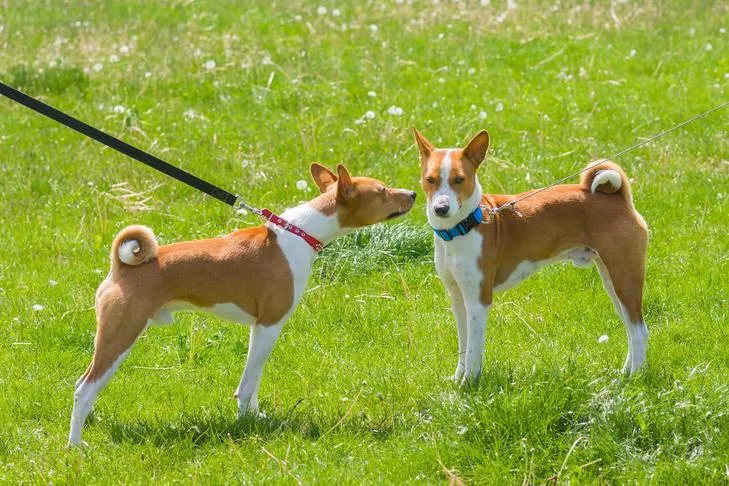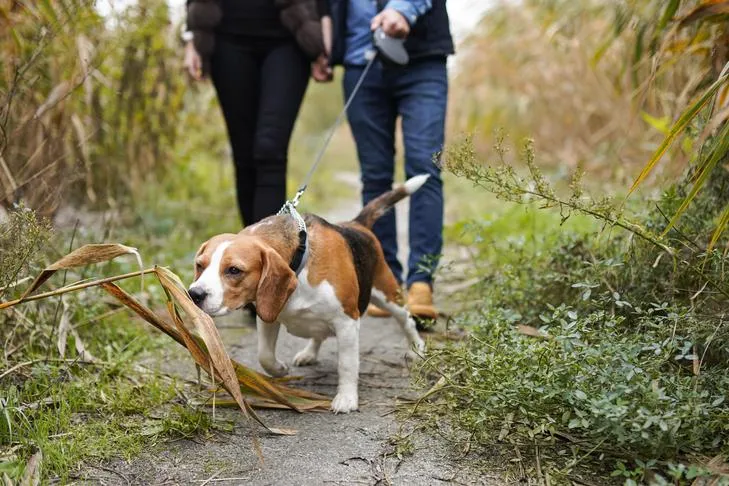Walking your dog should be a pleasurable experience, a time for bonding and exercise, not a constant struggle against a strong puller. Many dog owners find themselves dragged down the street, leading to frustration and potential injury, especially with larger breeds. The challenge of a dog pulling on the lead is a common one, but it’s crucial to address for both safety and enjoyment. In most public spaces, allowing your dog off-leash is not only against regulations but also poses risks, from altercations with other dogs to your pet running off. Keeping your dog leashed provides essential control, dictating their interactions and environment. This guide will outline the best way to stop your dog pulling on the lead, ensuring your walks are enjoyable and safe for both of you.
Fortunately, teaching your dog proper leash etiquette is achievable with the right approach and consistent effort. While leash pulling is a widespread issue, simple techniques, combined with adjustments in your own behavior during walks, can lead to significant improvements. By implementing the following strategies, you can transform your walks from a chore into a harmonious activity where you and your dog walk together, side by side.
Reward Good Leash Behavior Consistently
One of the most fundamental principles in dog training, and indeed the Best Way To Stop Your Dog Pulling On The Lead, is positive reinforcement. Never take your dog’s polite walking for granted. Dogs are more likely to repeat behaviors that are rewarded, whether that reward is a tasty treat, verbal praise, or the opportunity to explore an interesting sniff spot like a fire hydrant. If you only focus on correcting undesirable actions and overlook good behavior, your dog may resort to less appropriate methods to get what they want.
Always be prepared to reinforce your dog’s appropriate behavior. Carry treats with you on walks, or be ready with gentle praise and petting. Be generous with your rewards, letting your dog know you appreciate their calm and attentive walking. In the initial stages of training, reward frequently and heavily. As your dog’s skills improve, you can gradually reduce the frequency of food rewards and substitute them with “life rewards” like the chance to sniff a tree trunk or a controlled greeting with another friendly dog. This consistency is vital for all dogs, including puppies when they walk on a leash, establishing good habits from an early age.
Never Allow Forward Movement While Pulling
Your dog’s primary motivation for pulling is typically to move forward and reach something exciting. If you allow them to continue walking while they are pulling, you are inadvertently rewarding the very behavior you want to eliminate. This reinforces the pulling and will only exacerbate the problem in the long run. Therefore, a core rule is to stop immediately whenever your dog pulls on the leash. Plant your feet firmly and wait. Your dog will eventually respond by either looking back at you or loosening the tension on the leash.
 Two Basenjis, one on a leash, meeting in a grassy field during an outdoor walk.
Two Basenjis, one on a leash, meeting in a grassy field during an outdoor walk.
Wait for a Loose Leash Before Resuming
After you’ve stopped due to pulling, how do you know when it’s safe to start moving again? The key is to wait for a slack leash. The leash should hang in a relaxed J-shape, and your dog should ideally turn their attention back to you. This might take some time in the beginning, especially with a determined puller. However, your dog will eventually notice that forward progress has halted and will look or walk back to investigate. At that precise moment, offer praise and a treat positioned at your side, then calmly resume walking. You may find yourself stopping and starting every couple of steps initially, but your dog will quickly learn that pulling brings the walk to a halt, while a loose leash allows them to continue moving forward. It’s a foundational step to learn how to train a pug to walk on a leash and other breeds effectively.
Incorporate Life Rewards to Enhance Walks
Walks should be a rich and stimulating experience for your dog, offering more than just a bathroom break. They should provide both physical exercise and mental engagement. When you’re focused on teaching your dog not to pull, it can sometimes feel like these enriching aspects are missing. To boost your training and make walks more enjoyable, integrate “life rewards” for good behavior. These are everyday things your dog loves, such as the chance to sniff a particularly interesting shrub or a brief, polite greeting with a friendly stranger. For instance, if your dog walks 10 feet without pulling, release them to sniff for a few minutes. These bonus rewards genuinely convince your dog that walking politely pays off.
Maintain a Good Walking Pace
Often, humans walk at a pace that is too slow for dogs. Even small toy breeds often have a quicker natural gait than their human companions. This difference in pace is often a contributing factor to dogs pulling—they simply want to get moving faster. To help your dog feel more connected and engaged in the walk, choose a pace that is comfortable for both of you. While you can certainly train your dog to match your speed precisely, a slightly quicker pace during the initial training phases can make it easier for them to learn not to pull on the lead.
Be Consistent with Your No-Pulling Rule
It can be incredibly tempting to let your dog pull occasionally, especially when you’re in a rush, perhaps running late for an appointment, or when the weather is unpleasant. However, consistency is paramount when training your dog not to pull. Any time you permit your dog to pull on the leash, you are effectively setting your training back to square one. Until your dog reliably walks with a loose leash for more than a few feet, it’s best to allow them to do their business in the yard or at the curb and reserve walks for dedicated training sessions when you have ample time to reinforce the no-pulling rule. This consistency is key for anyone trying to figure out how to train dog not to tug on leash effectively.
 A Beagle dog actively pulling on its leash to sniff the ground during an outdoor walk.
A Beagle dog actively pulling on its leash to sniff the ground during an outdoor walk.
Keep Training Sessions Short and Fun
Working with a dog that is a persistent leash puller can be frustrating. In the early stages, you might not make it much further than the end of your driveway. Instead of pushing your dog to the point where both of you become irritable due to a lack of progress, keep your training sessions brief and positive. Puppies, in particular, have very short attention spans, and expecting too much too soon will likely yield negative results. Remember, the objective isn’t to cover a certain distance; it’s to achieve a loose leash walk, even if that means only making it to the neighbor’s house and back.
Be Interesting and Engaging During Walks
For dogs, the world is a thrilling place, filled with an abundance of new sights, sounds, and most notably, smells. This means there are numerous distractions constantly vying for your dog’s attention, enticing them to pull you along the sidewalk. If you’re engrossed in your phone or otherwise disengaged from your dog, there’s little incentive for them to pay attention to you. However, if you are interesting and engaging, your dog will be much more likely to follow your lead. Talk to your dog, incorporate quick training breaks, stop for a brief game, or simply vary your pace. This keeps your dog guessing and attentive to what you might do next.
Maintain Calmness in All Situations
 A calm Cavalier King Charles Spaniel walking on a lead outdoors in a park-like setting.
A calm Cavalier King Charles Spaniel walking on a lead outdoors in a park-like setting.
Whether it’s an exciting encounter with a favorite neighbor or the approach of a barking dog, walks can present a variety of emotionally charged situations. Regardless of whether these situations are exciting or frightening for your dog (and for you), it’s vital to control your own emotions. Dogs are exceptionally skilled at interpreting human emotions, and your mood can be transmitted down the leash, impacting your dog. This can either further heighten their excitement or intensify their anxiety. To help your dog remain calm, it is crucial that you stay calm yourself. Demonstrate to your dog that there is nothing to be overly excited or fearful about. The more relaxed your dog is, the more receptive they will be to your cues and more likely to behave appropriately on the lead.
Engage Your Dog in Distracting Situations
When you encounter distractions such as other dogs, squirrels, or even suspicious-looking objects, it’s easy for your dog to forget their leash manners and start pulling. Similarly, if strangers make your dog nervous, they might pull to approach or to retreat. In either scenario, good leash behavior can quickly be abandoned.
To help your dog manage these distractions, redirect their focus back to you. Calmly offer them treats or initiate a quick game. For example, ask for a “sit” or a “hand target.” These simple exercises keep your dog engaged with you as the distraction passes. You can also teach your dog the “watch me” cue to establish eye contact, which gives you more control over where they’re looking. The key is to be proactive: grab your dog’s attention before they notice the distraction, and with practice, they might not even register it at all. Mastering these techniques contributes to better overall control, even paving the way to eventually teaching your dog to come off leash responsibly in safe, designated areas.
Conclusion
Teaching your dog to walk politely on a leash is a rewarding endeavor that transforms your daily outings into pleasant experiences for both of you. The best way to stop your dog pulling on the lead involves a combination of positive reinforcement, immediate cessation of forward movement when pulling occurs, and consistent, engaging training. By patiently applying these ten strategies—rewarding good behavior, stopping when they pull, waiting for a loose leash, using life rewards, maintaining a good pace, ensuring consistency, keeping sessions short and fun, being engaging, staying calm, and actively managing distractions—you will foster a stronger bond with your dog and enjoy harmonious walks together. With dedication, you can turn a tug-of-war into a synchronized stroll.
